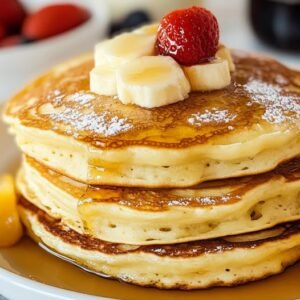Prepare to meet a cake that will change your definition of “sponge.” If your experience with sponge cake is limited to the sometimes-dry, airy versions common in the West, the Japanese Castella cake will be a revelation. This is a cake that is a true marvel of baking science. It’s famous for its incredible, springy texture—so bouncy you can press it down and watch it spring right back. It has an impossibly fine, moist, and tender crumb, a beautiful dark golden crust on the top and bottom, and a delicate, elegant flavor of honey that lingers on the palate.

Brought to Japan by Portuguese merchants in the 16th century, this cake has been perfected over centuries into a national treasure. Making one at home is a rewarding challenge that is less about a long list of ingredients and more about technique and patience. The result is a cake that is simple, sophisticated, and utterly unique.
Why I Love This Recipe
I am completely fascinated by the process of making a Castella cake. It’s a recipe that feels like a beautiful, delicious science experiment. The magic lies in creating a perfectly stable meringue and gently folding it into the batter to create a structure that is both strong and incredibly light. There are no chemical leaveners like baking powder or soda; the lift comes purely from the air whipped into the eggs.
The payoff for your careful technique is a texture unlike any other. It’s chewy yet tender, moist yet light, and the subtle sweetness from the honey makes it incredibly refined. It’s the kind of cake that doesn’t need frosting or any adornment. A thick, neat slice served on its own is a simple, perfect pleasure. It’s a baking project that will leave you with a deep sense of accomplishment and a truly special dessert to share.
Ingredients
The ingredient list is simple, making the quality of each one and your technique paramount.
- 6 large Eggs, separated and at room temperature
- 1/2 cup + 2 tbsp (125g) Granulated Sugar, divided
- 1/4 cup (85g) Honey
- 2 tbsp Milk
- 3/4 cup + 2 tbsp (120g) Bread Flour
- Pinch of Salt
Swaps and Notes:
- Eggs: The eggs are the star of the show, providing both leavening and richness. It’s crucial that they are at room temperature, which allows them to whip up to their fullest volume.
- Bread Flour: This is not a typo! Bread flour has a higher protein content than all-purpose flour. This extra protein provides the structure needed to support the airy meringue, resulting in Castella’s signature chewy and bouncy texture. If you must, you can use all-purpose flour, but the texture will be slightly less springy.
- Honey: This provides the cake’s signature flavor and helps keep it incredibly moist. A light-colored, mild honey like clover or acacia is a good choice.
Step-by-Step Instructions
The technique is everything with this cake. Read through the steps carefully before you begin.
- Prepare the Pan: Preheat your oven to a low 320°F (160°C). For this cake, you need to create a parchment paper “box” inside your pan. Use a standard 8.5×4.5 inch loaf pan. Cut a long piece of parchment that will cover the bottom and the two long sides, leaving a couple of inches of overhang to act as handles. Cut another piece to fit the bottom and the two short sides. This prevents the cake from forming a hard crust on the sides and allows it to rise evenly.
- Prepare the Wet Ingredients: In a small, microwave-safe bowl, combine the honey and milk. Warm it in the microwave for about 20-30 seconds. You want it warm, not hot. This helps it incorporate smoothly into the batter.
- Make the Yolk Batter: In a large bowl, whisk the 6 egg yolks with 2 tablespoons of the sugar until pale and creamy. Whisk in the warm honey and milk mixture until combined.
- Make the Meringue: In the very clean bowl of a stand mixer fitted with the whisk attachment, beat the 6 egg whites and the pinch of salt on medium speed until foamy. Gradually add the remaining 1/2 cup of sugar, one tablespoon at a time, while beating. Once all the sugar is added, increase the speed to medium-high and beat until the meringue is thick, very glossy, and holds stiff peaks. A perfect meringue is the key to this cake!
- Fold the Meringue (The Most Important Part): Add about one-third of the meringue to your egg yolk batter and fold it in gently with a spatula to lighten the mixture. Add the remaining meringue in two more additions, folding very gently but thoroughly after each one. The goal is to incorporate the meringue without deflating all the air you just whipped into it. Scrape the bottom of the bowl to ensure everything is combined.
- Add the Flour: Sift the bread flour over the batter in two additions, folding gently after each one until you no longer see streaks of flour. Again, do not overmix.
- Pour and Bake: Pour the finished batter into your prepared loaf pan. To remove any large air bubbles, gently run a skewer or chopstick through the batter in a zig-zag pattern. Then, tap the pan firmly on the counter a couple of times.
- Bake Low and Slow: Bake for 40-50 minutes, until the top is a deep golden brown and a skewer inserted into the center comes out clean.
- The Post-Bake Steam: As soon as you remove the cake from the oven, drop the pan from a height of about 6 inches onto the counter. This shocking action helps prevent the cake from shrinking too much. Let it cool in the pan for 2-3 minutes.
- Wrap and Rest: Use the parchment handles to lift the cake out of the pan. While still hot, wrap the entire cake (parchment and all) tightly in plastic wrap. Place it on a wire rack, upside down, to cool completely. This unconventional step traps the steam, creating an incredibly moist and fine crumb. Let it rest like this for at least 8 hours, or overnight at room temperature.
Tips for Success
- A Perfect Meringue is Everything: Use a spotlessly clean bowl, ensure no yolk gets into your whites, and beat to a stiff, glossy peak. The meringue should be firm but still pliable enough to fold.
- Fold, Don’t Stir: The folding motion is crucial for maintaining the air in the batter. Cut down the middle with your spatula, scrape along the bottom, and “fold” the batter over on itself.
- Low Temperature is Key: Baking this cake at a high temperature will cause it to rise too quickly and then collapse, resulting in a dense, cracked cake. Be patient.
- Don’t Skip the Overnight Rest: This is where the Castella magic happens. The texture and flavor improve immensely after the wrapped resting period.
Serving Suggestions
After its long rest, unwrap your beautiful cake. Use a long, serrated knife to trim the dark bottom crust (optional, for aesthetics) and slice it into thick, 1-inch pieces. Castella is best served at room temperature, all on its own, to be fully appreciated. It pairs beautifully with a simple cup of Japanese green tea or black coffee.
Storage and Leftover Tips
- Storage: Store the cake, tightly wrapped in plastic wrap or in an airtight container, at room temperature for up to 4-5 days. It will become even more moist and flavorful on day two!
More Recipes You Will Love
If you enjoy fun and creative baking projects, you’ll love these other colorful treats:
- For a cake that’s all about fun and color, check out How This Unicorn Poke Cake Became My Favorite Party Trick.
- Brighten any day with These Spring Flower Pretzel Bites.
- For pure, joyful color, make These Rainbow Sprinkle Cookies.
- And for a truly unique party trick, try These Jolly Rancher Edible Shot Glasses.
Final Thoughts
The journey of making a Castella cake is as delightful as the final product. It teaches patience, precision, and the beauty of simplicity. Taking that first bite of your own homemade, impossibly bouncy, and fragrant honey sponge is a moment of pure baking triumph. I hope you’ll take on the challenge—it’s worth every second.
Let me know about your Castella adventures in the comments below!




Leave a Reply